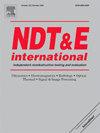Detecting of interfacial defects in CFRP−concrete bonded joints using dynamic speckle patterns of excited surface
IF 4.5
2区 材料科学
Q1 MATERIALS SCIENCE, CHARACTERIZATION & TESTING
引用次数: 0
Abstract
An optical-acoustic method (OAM) for identification of interfacial defects in carbon fibre reinforced polymer (CFRP)−concrete bonded joints is proposed. To detect and identify defects by this method, the unidirectional CFRP plate is excited by a harmonic elastic waves, and a series of dynamic speckle patterns (DNSPs) of the plate surface is produced by an imaging system. The local area of the plate directly above the interfacial defect, i.e. a region of interest (ROI), is considered as a circular membrane that oscillates at its fundamental resonance frequency under the action of an elastic wave. An optical-acoustic system (OAS) mock-up implementing this method, after generating and registering the DNSPs sequences allows forming an optical spatial response from the ROI and determining its dimensions, close to dimensions of a detected interfacial defect. To verify the proposed OAM, series of artificial circular disbonds in CFRP-concrete bonded joints were produced and optical spatial responses at the fundamental resonance frequency of each defect were obtained using the developed OAS mock-up. It is shown that obtained experimental dependency of the fundamental resonance frequency on the artificial defect radius is close to the same theoretical dependence plotted on the basis of the Rayleigh quotient frequency.
利用激发表面动态散斑图检测CFRP -混凝土粘结接头界面缺陷
提出了一种用于碳纤维增强聚合物(CFRP) -混凝土粘结接头界面缺陷识别的光声方法(OAM)。为了检测和识别缺陷,该方法利用谐波弹性波对CFRP单向板进行激励,通过成像系统在板表面产生一系列动态散斑图(DNSPs)。直接在界面缺陷上方的板的局部区域,即感兴趣区域(ROI),被认为是在弹性波的作用下以其基共振频率振荡的圆膜。实现这种方法的光声系统(OAS)模型,在生成和注册DNSPs序列后,可以从ROI形成光学空间响应并确定其尺寸,接近检测到的界面缺陷的尺寸。为了验证所提出的OAM,在cfrp -混凝土粘结缝中制造了一系列人工圆形脱粘,并利用所开发的OAS模型获得了每个缺陷在基共振频率下的光学空间响应。结果表明,实验得到的基共振频率对人工缺陷半径的依赖关系与瑞利商频率绘制的理论依赖关系接近。
本文章由计算机程序翻译,如有差异,请以英文原文为准。
求助全文
约1分钟内获得全文
求助全文
来源期刊

Ndt & E International
工程技术-材料科学:表征与测试
CiteScore
7.20
自引率
9.50%
发文量
121
审稿时长
55 days
期刊介绍:
NDT&E international publishes peer-reviewed results of original research and development in all categories of the fields of nondestructive testing and evaluation including ultrasonics, electromagnetics, radiography, optical and thermal methods. In addition to traditional NDE topics, the emerging technology area of inspection of civil structures and materials is also emphasized. The journal publishes original papers on research and development of new inspection techniques and methods, as well as on novel and innovative applications of established methods. Papers on NDE sensors and their applications both for inspection and process control, as well as papers describing novel NDE systems for structural health monitoring and their performance in industrial settings are also considered. Other regular features include international news, new equipment and a calendar of forthcoming worldwide meetings. This journal is listed in Current Contents.
 求助内容:
求助内容: 应助结果提醒方式:
应助结果提醒方式:


